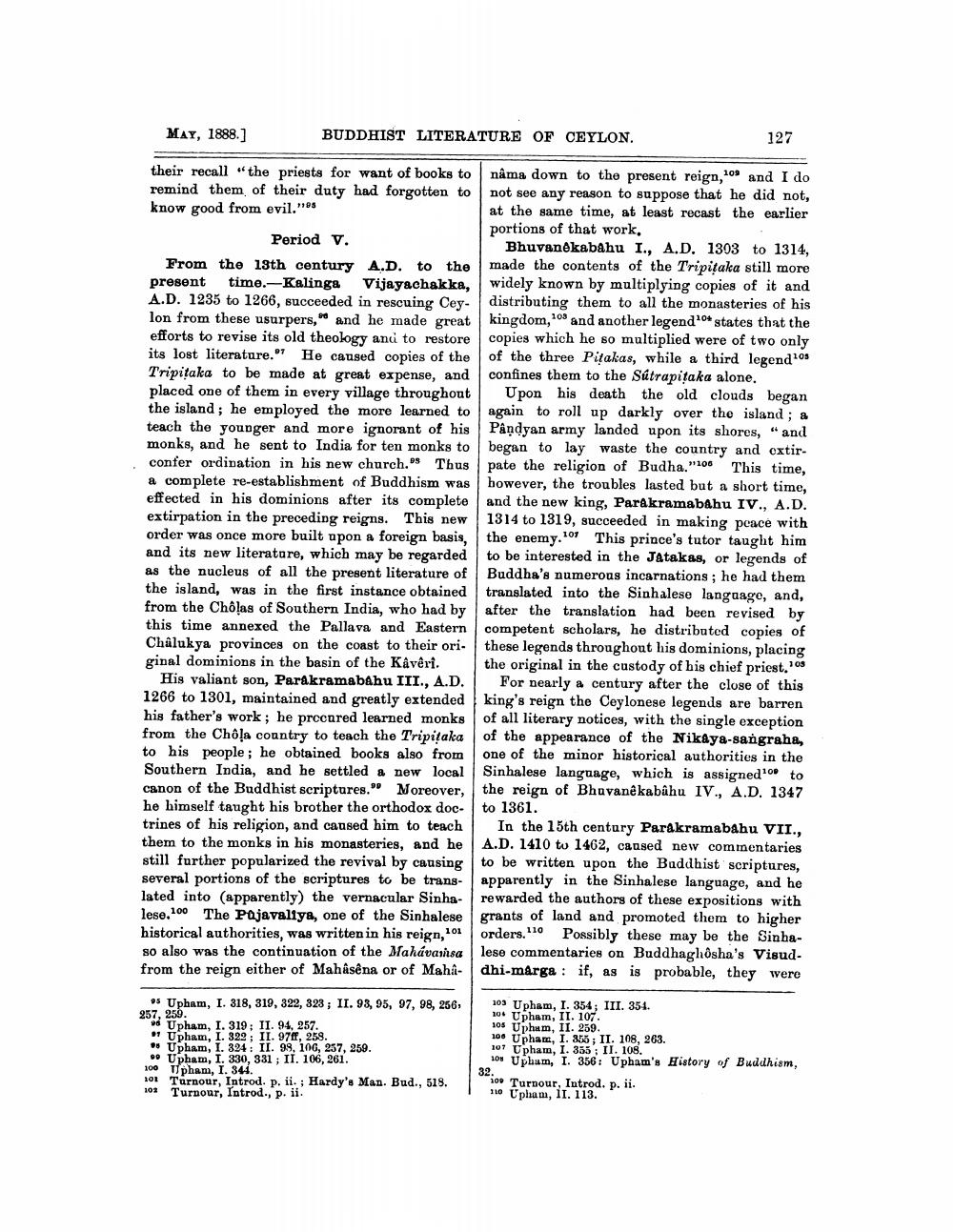________________
MAY, 1888.]
BUDDHIST LITERATURE OF CEYLON.
127
their recall "the priests for want of books to nama down to the present reign, 109 and I do remind them of their duty had forgotten to not see any reason to suppose that he did not, know good from evil."
at the same time, at least recast the earlier
portions of that work, Period v.
Bhuvanekabahu I., A.D. 1303 to 1314, From the 13th century A.D. to the made the contents of the Tripitaka still more present time.-Kalinga Vijayachakka, widely known by multiplying copies of it and A.D. 1235 to 1266, succeeded in rescuing Cey- distributing them to all the monasteries of his lon from these usurpers, and he made great kingdom, 18 and another legend 10 states that the efforts to revise its old theology and to restore copies which he so multiplied were of two only its lost literature. He caused copies of the of the three Pitakas, while a third legendos Tripitaka to be made at great expense, and confines them to the Sútrapitaka alone. placed one of them in every village throughout Upon his death the old clouds began the island; he employed the more learned to again to roll up darkly over the island ; & teach the younger and more ignorant of his Pandyan army landed upon its shores, "and monks, and he sent to India for ten monks to began to lay waste the country and extirconfer ordination in his new church." Thus pate the religion of Budha."196 This time, a complete re-establishment of Buddhism was however, the troubles lasted but a short time, effected in his dominions after its complete and the new king, Parakramabahu IV., A.D. extirpation in the preceding reigns. This new 1314 to 1319, succeeded in making peace with order was once more built upon a foreign basis, the enemy.107 This prince's tutor taught him and its new literature, which may be regarded to be interested in the Jatakas, or legends of as the nucleus of all the present literature of Buddha's numerous incarnations: he had them the island, was in the first instance obtained translated into the Sinhalese language, and, from the Cholas of Southern India, who had by after the translation had been revised by this time annexed the Pallava and Eastern competent scholars, he distributed copies of Châlukya provinces on the coast to their ori- these legends throughout his dominions, placing ginal dominions in the basin of the Kâvêri. the original in the custody of h
the original in the custody of his chief priest." His valiant son, Parakramabahu III., A.D. For nearly a century after the close of this 1266 to 1301, maintained and greatly extended king's reign the Ceylonese legends are barren his father's work; he procured learned monks of all literary notices, with the single exception from the Chôļa country to teach the Tripitaka of the appearance of the Nik&ya-sangraha, to his people; he obtained books also from one of the minor historical authorities in the Southern India, and he settled a new local Sinhalese language, which is assigned to canon of the Buddhist scriptures. Moreover, the reign of Bhuvanêkabâhu IV., A.D. 1347 he himself taught his brother the orthodox doc- to 1361. trines of his religion, and caused him to teach 1 In the 15th century Parakramabahu VII., them to the monks in his monasteries, and he A.D. 1410 to 1462, caused new commentaries still further popularized the revival by causing to be written upon the Buddhist scriptures, several portions of the scriptures to be trang- apparently in the Sinhalese language, and he lated into (apparently) the vernacular Sinha- rewarded the authors of these expositions with lese.100 The Pajavaliya, one of the Sinhalese grants of land and promoted them to higher historical authorities, was written in his reign, ou orders.110 Possibly these may be the Sinhaso also was the continuation of the Mahavarisa lese commentaries on Buddhaghôsha's Visudfrom the reign either of Mahasena or of Maha- dhi-marga : if, as is probable, they were
• Upham, I. 318, 319, 322, 323 ; II. 93, 95, 97, 98, 256, 257, 259.
Upham, I. 319; II. 94, 257. " Upham, I. 329; II. 97ff, 258.
5 Upham, I. 324: II. 99, 100, 257, 259. * Upham, I. 330, 331 ; II. 106,261. 100 Upham, I. 341. 101 Turnour, Introd. p. ii.; Hardy's Man. Bud., 518. 101 Turnour, Introd., p. ii.
103 Upham, I. 354; III. 351. 20. Upham, II. 107. 105 Uphum, II. 259. 10. Upham, I. 355 ; II. 108, 263. 107 Upham, I. 355 ; IL 108.
104 Uphum, I. 356: Upham's History of Buddhism, 32.
10Turnour, Introd. p. ii. 110 Upham, II. 113.
1




